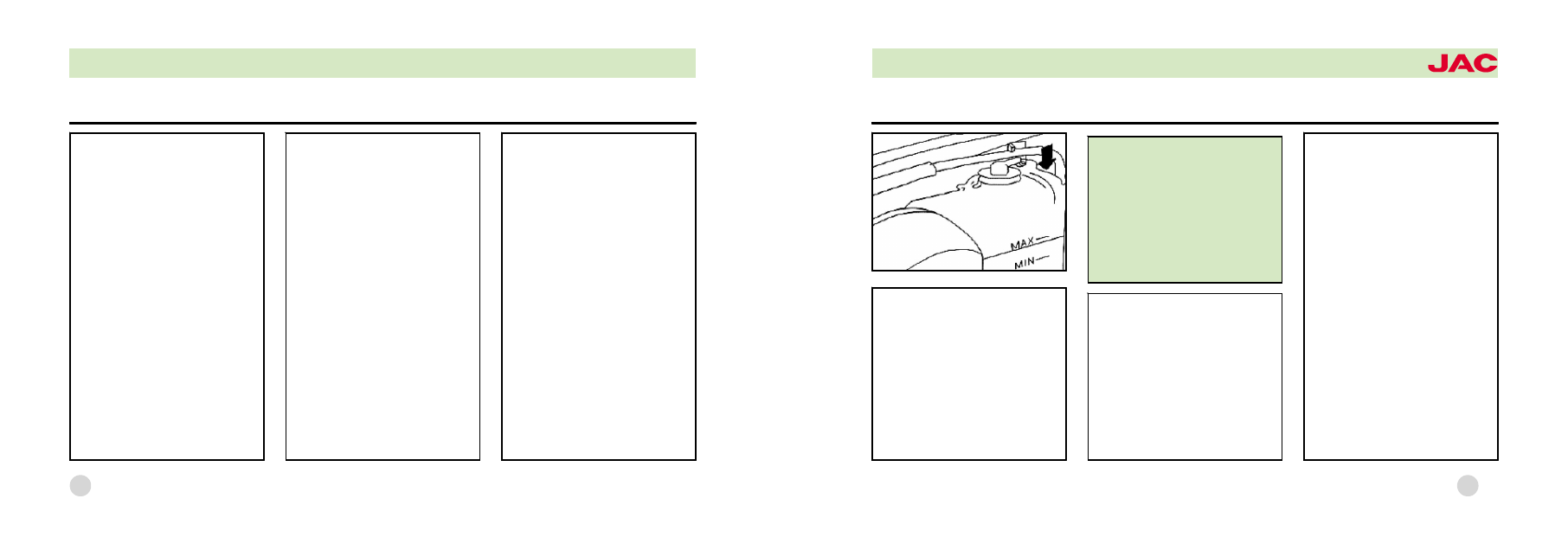JAC Pick-Up. Manual - part 8

Cooling System
Examining Coolant Level
A partially highlighted engine
bay layout is shown in the figure.
The compensator is situated
next to front enclosure for the
engine bay - refer to the figure
for details.
Caution:
Do not open the hood and avoid
possible scalding when steam or
coolant has been found coming
out from the engine bay. Open
the hood until nothing unsafe has
been identified.
The coolant level can only be
examined when the engine is
turned off.
For a cold engine, the level can
range between Min and Max in
the compensator. For a hot en鄄
gine, it can be slightly higher
than Max.
Loss of Coolant
The leakage mainly contributes
to coolant losses. In this case,
the cooling system shall be ex鄄
amined immediately at the fran鄄
chised JAC service providers. It
can not solve the problem by
simply refilling. In a closed sys鄄
tem, only overflow due to boil鄄
ing can reduce its amount.
Refilling Coolant
Turn off the engine and wait un鄄
til it gets cooled. Use a piece of
cloth to cover the cap of the
compensator before loosening it
anti-clockwise.
3 -13
Cooling System
A long -life coolant, made up of
water and 40% cooling agent pro鄄
vided by the manufacturer (com鄄
prising ethylene glycol anti-freez鄄
ing agent and corrosion inhibitor)
has been added into the cooling
system at factory, which can pro鄄
vide anti -freezing protection at -
25益 in addition to corrosive treat鄄
ment for all light alloy parts. More鄄
over, less sediment will be pro鄄
duced and the boiling point can
be increased dramatically.
As a result, the coolant concentra鄄
tion is not allowed to be reduced
by adding water in warm seasons
and regions. The cooling agent
must account for 40%.
Where more strong anti -freezing
protection is required due to cli鄄
mate demands, the percentage
can be increased accordingly,
however not more than 60% (at -
40益). Otherwise the cooling effi鄄
ciency may be compromised.
For vehicles exported to cold
countries, the percentage of cool鄄
ing agent has been increased with
a view to protection at -35益.
Use only recommended agent for
the coolant (Note instructions on
label) which is provided by fran鄄
chised JAC service providers only.
Other unauthorized brands may
apparen tly impair anti -corrosive
protection. This may lead to
coolant loss and serious engine
faults in the end.
Notes
Use only recommended agent for
the coolant (Note instructions on
label) which is provided by fran鄄
chised JAC service providers only.
Notes for refilling:
G12 is allowed to mix with other
brands (including G11) under no
circumstances. You can tell that
the coolant in the reservoir has
been mixed if its color is not green
any more. Replace coolant imme鄄
diately in this case or it may result
in severe functional failures.
3 -12
OWNER爷S MANUAL
pick-up